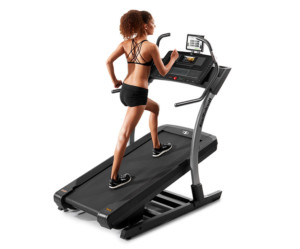
You know that running burns a lot of fat (if intense enough), but what about grueling incline walking, either on a treadmill or outdoors?
In my days as a personal trainer at a health club, I had my clients do level running and also incline walking.
A person, either novice, intermediate or advanced, can do both running (zero incline) and incline walking.
The only condition under which I’d recommend that you do only one of these forms of exercise is if a physical situation is preventing you from doing the other.
But if you’re good to go for both, then do both. Your body will respond better to variety.
Also, doing more than one type of cardio exercise will help prevent boredom.
You can combine incline walking and jogging into one session, something that you can do on a hiking trail.
Now, on a treadmill, you can adjust the settings accordingly for periods of running level mixed with periods of incline walking.
Both types of exercise offer heart benefits, as long as you are going at a challenging pace.
Which burns more fat though: flat running or incline walking?

Both types of aerobics will burn fat and improve fitness. Will incline walking make you a faster runner? No.
Will running level make it easier for you to walk up hills? Not really.
It’s also tough to quantitate the amount of fat burned doing flat running vs. walking at an incline.
The speed of the run factors into this comparison. So does the steepness of the incline and the speed of the walk.
If you’re applying high intensity interval training to incline walking, you will burn a lot more fat when compared to steady state (paced) jogging for the same length of session time.
If you’re doing steady state walking up an inclined trail or treadmill, you’ll burn LESS fat than if you were applying high intensity interval training to a running session on a flat course.
The recruitment pattern of muscles is different for incline walking vs. flat running. This is why one never replaces the other.

Incline walking recruits the Achilles tendon and lower calf in a different way when compared to level running.
Walking up a slope is done with a full foot strike, and running — when done fast enough — is done off the balls of one’s feet.
You can spend your entire treadmill session at an incline, alternating between walking, jogging and running. Do not hold onto the machine.
Or, you can set the treadmill at zero incline and do some jogging, then add a grade and do walking but no running. Again, do not hold onto the machine.
Outdoors, if you feel like running up a slope, then do so. Or, you can walk it as fast as possible for a short duration, or a bit slower for a long duration, depending on the length of the hill.
On level areas, jog, run or sprint.
Both modes of exercise–flat running and incline walking–have the potential to burn a significant amount of fat when high intensity interval training is applied.
 Lorra Garrick is a former personal trainer certified through the American Council on Exercise. At Bally Total Fitness she trained women and men of all ages for fat loss, muscle building, fitness and improved health.
Lorra Garrick is a former personal trainer certified through the American Council on Exercise. At Bally Total Fitness she trained women and men of all ages for fat loss, muscle building, fitness and improved health.
.
























